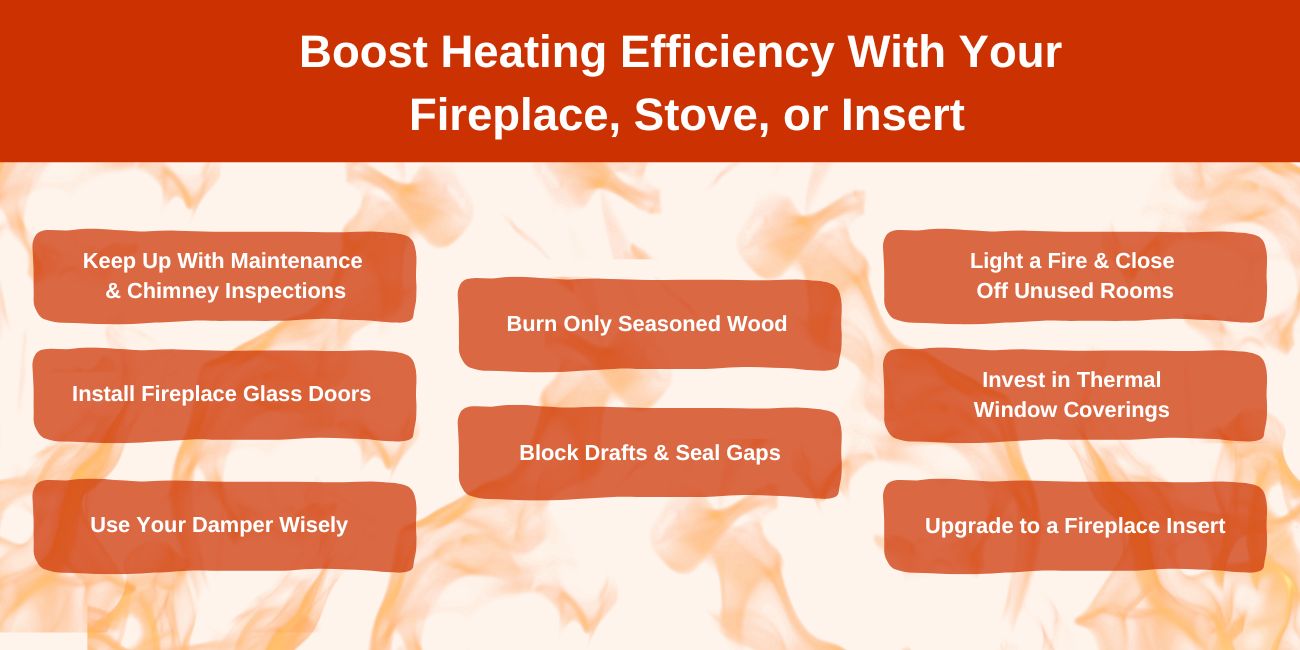If you’re lucky enough to have a fireplace to lighten up the winter darkness, it only makes sense to utilize it to the max. Not only does a fire add light and charm, it can cut down heating bills and drive out the chill. That said, not every fireplace out there is running as efficiently as it could be.
How can you get the most out of your fireplace in terms of both warmth and energy efficiency?

1. Keep Up With Fireplace Maintenance & Chimney Inspections
Maintaining any home system is important. It helps keep your appliances – in this case, the fireplace – functional and preserves their longevity. But not only do maintenance and routine inspections keep things operating as they should, they help maximize how well the system works for you. As a matter of fact, it’s one of the most important steps in improving – and maintaining – efficiency.
Over time, chimneys can accumulate creosote and soot, which can cause blockages or become fire hazards. Other blockages can also occur due to animal invasion or outside debris flying in. A blocked or dirty chimney pinches off airflow and causes poor combustion, which means your fire isn’t going to burn as well. It may also cause a smokier fire, as well as exacerbate your issue with creosote build-up. And it definitely isn’t safe, potentially increasing your risk of experiencing fire hazards and gas leaks.
Scheduling an annual chimney inspection and sweeping will get expert hands and eyes on your chimney, heading off potential problems earlier and keeping things in consistently good shape.
2. Install Fireplace Glass Doors
Fireplace doors may seem like a merely decorative feature, but they bring function as well as form. A fireplace’s glass doors help keep heat from escaping up the chimney when the fireplace isn’t being used, and they can also help block the cold downdrafts. This can spell energy savings – just make sure the doors you select fit and seal well for maximum effectiveness. Trusting a professional for installation is the way to go.
3. Use Your Damper Wisely
A fireplace damper is a metal plate that either sits at the base of the chimney (a throat damper) or at its top (a top-mount damper). In either location, the damper helps regulate ventilation. Leaving it open allows heated air and combustion byproducts to get out, which is vital – but when you aren’t using the fireplace, the damper should always be closed.
A closed damper traps warm/heated air inside, which helps you maintain a comfortable temperature in your home. A well-functioning damper with a good seal that isn’t rusty or damaged will aid efficiency, so if you have any concerns about your damper, be sure to let your chimney technician know.
4. Fuel Your Fires Well
If you have a wood-burning fireplace or insert, always – and only – use well-seasoned wood. This simply means that your wood has been dried for a considerable length of time so that it can burn better – this usually takes about six months to achieve. Freshly cut wood has a high level of moisture, so burning it won’t go as well – it’ll be a smokier fire, create more creosote in your flue, and give a weaker heat output. Dry, seasoned wood burns more efficiently, producing more heat and causing less buildup to stick in the chimney.
5. Block Drafts & Seal Gaps
Even if your burning practices are good, you can still lose heat if you have cracks or gaps around doors, windows, or the fireplace in your home. Air can seep through these spaces, and that in turn can make your heating system work harder. If any seals in your home leave something to be desired, use appropriate caulk or weather stripping to stop drafts and heat loss.
6. Light a Fire & Close Off Unused Rooms
If there’s a room that isn’t steadily used, such as a guest room or area of your basement, consider closing it off to focus heat where you need it most. Closing doors and vents will keep these rooms cooler until you need them, which could save you on heating costs.
This is referred to as zone heating, and it’s a great method for those with a stove, insert, or fireplace. Simply start up your fire, gather around the hearth, and then lower your thermostat. Everyone will still stay warm and cozy, and your heating bills won’t suffer as a result.
7. Use Thermal Window Coverings
A simple way to hold onto heat is to use thermal curtains or blinds over windows, particularly those near the fireplace. When the sun shines during the day, open things up to let natural heat in. Then, when night falls, close your thermal blinds or curtains to retain warmth inside your living space.
8. Consider What a Fireplace Insert Can Do for You
If you have an open fireplace and are looking for a more substantial boost in efficiency, it might be time to weigh the benefits of installing a fireplace insert. What is an insert? It’s a prefabricated, self-contained unit that fits into an existing fireplace opening.
Fireplace inserts are designed to capture and re-circulate heat that would otherwise be lost up the chimney. This can keep you warmer, while allowing you to turn down the heat in other areas of the home. Another advantage? You can convert the type of fuel your system uses while you’re at it. If you’ve been wishing to switch from wood to gas, adding a gas fireplace insert to your open wood fireplace is one of the most straightforward ways to do it.
Call Us for Fireplace Inspections, Maintenance, Repair & Upgrades
If it’s time for a chimney inspection, sweeping, or a fireplace upgrade, don’t wait to get in touch with our team of experts. At Ashbusters, we put our expertise to work for you when it comes to keeping things running smoothly, safely, and efficiency. Reach out today!
